If you would like to get email notices when a new list appears, send your email address. No other details are necessary.

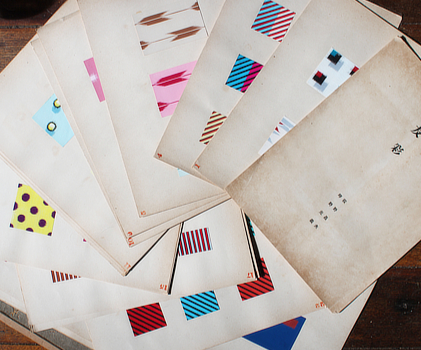
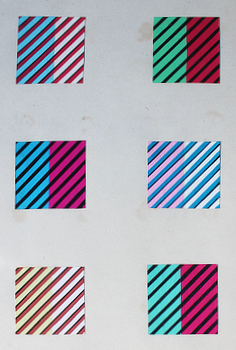
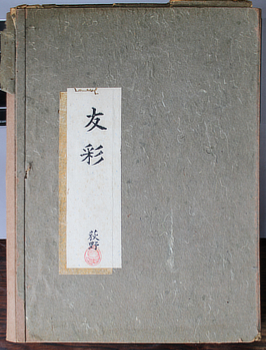

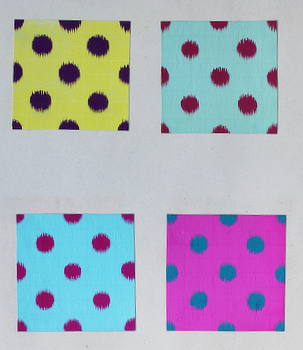
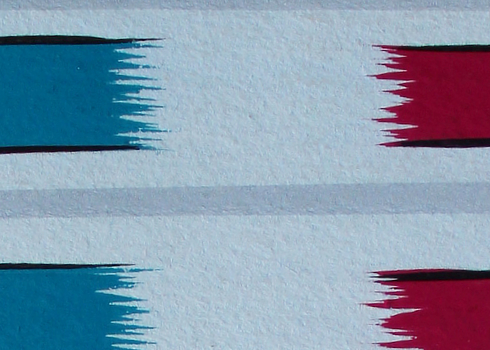

Ogino Masao & Tsuboi Motoyoshi 友彩 [Yusai]. Tokyo, Ogino & Tsuboi? 1943 (Showa 18). 32x24cm, loose as issued publisher's folding card case (bottom flap missing, top ragged along the fold), printed paper label over a gold label. Title page and 28 numbered leaves with 126 mounted colour designs. Title browned, a little browning of the mounting leaves. Au$1850
Beautifully printed and mysterious; what more can anyone ask of a colour book? The colour printing is crisp, saturated and vivid. Yusai translates literally as 'friend colour' - a glazing technique using colours is called yusai - but what it really means other than colours friendly to each other I don't know. Neither do I know who Ogino and Tsuboi are. Ogino's name and seal is on the title slip, both names are on the title page and the colophon slip pasted inside the back cover. Beyond this is mystery.
How and why was something like this produced in 1943? A kimono pattern book out of Kyoto or Osaka is one thing but this is a colour grammar out of Tokyo. Textile patterns are used but the designs are secondary. Two names, two Tokyo addresses, and the year are all the information we have.
I can find no mention it exists.
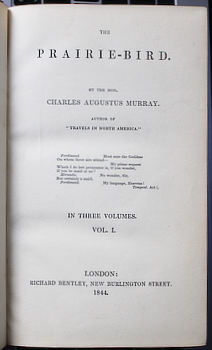
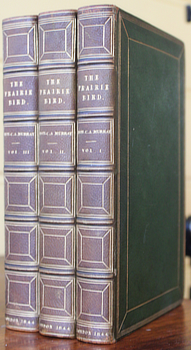

From mother to mother?
MURRAY, Charles Augustus. The Prairie-Bird ... in three volumes. London, Bentley 1844. Three volumes octavo gilt decorated green morocco (spines a bit faded, edges a bit rubbed). A handsome, crisp copy with the bookplate of Augusta FitzPatrick and an 1844 gift inscription from her affectionate aunt S. Dunmore* in Brighton. Au$800
First edition of a three decker love letter. Murray was a golden boy whose talent and promise maybe outweighed his achievements but he left an enviable c.v. He was exceedingly handsome and agreeable, an athlete, a classicist, a linguist expert in oriental languages, met Goethe, and brought the first hippopotamus to England.
In 1835 he spent a year travelling with a Pawnee tribe which formed his Travels in North America (1839) and this novel. In America he fell in love with heiress Elise Wadsworth but her father forbade all communication between them. Wadsworth senior finally died and they were married in 1850. In the meantime the only intercourse between them was, apparently, by this novel in which he hid the secret code that he "remained faithful and would always remain so" (A.L. Rowse).
Murray's constancy, even if it was known to his family at the time, surely can't have been Augusta's aunt's reason for gifting the book. Augusta seems remembered now mainly as one of the distinguished women who had an affair with Anglican cleric F.W. Robertson - even more of a golden boy than Murray - who apparently wrote in secret code in his diary of his affairs with the women of Brighton. Perhaps aunt Dunmore hoped North American Indians would distract her straying niece. In any case, it didn't work. There are no signs that the book was ever opened again once the bookplate went in.
*Still, it's all a family matter. Elise died the year after they married and after a decent pause Murray married Augusta's daughter, his cousin, Edith FitzPatrick. Charles' father and older brother were Earls of Dunmore, his mother was born Susan Douglas-Hamilton; Augusta was born Augusta Mary Douglas ...
If I have this straight, then it's a gift from the author's mother to her niece, the author's mother-in-law to be. As Edith was only three or four when this book was published I hope this wasn't all arranged.
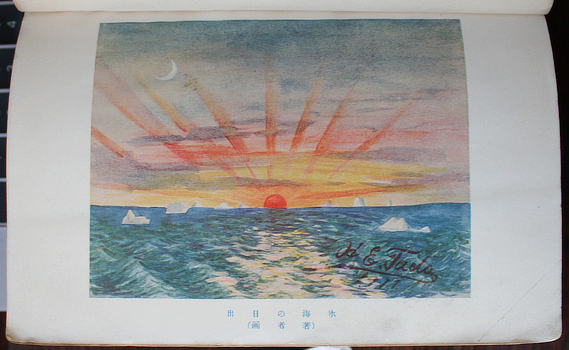
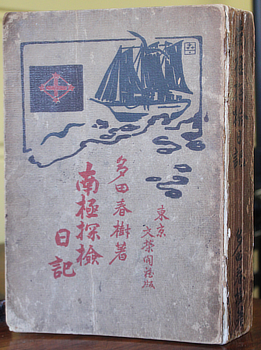
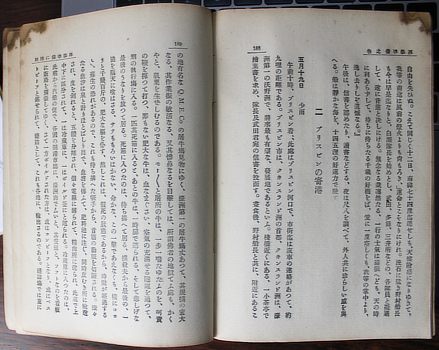
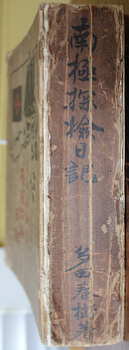

Tada Keiichi. 南極探検日記 [Nankyoku Tanken Nikki]. Tokyo, Maekawa Bun'eikaku 1912 (Taisho 1). 19x13cm publishers illustrated card wrapper (quite worn but complete and solid); [2],[2],668pp plus plates, colophon and publisher's adverts; 29 illustrations on 22 plates including two maps and three colour plates. A small dark stain in a corner of a hundred odd pages; definitely used. The colophon date is a slip pasted over the Meiji date; the Emperor died only five days before this was published. Au$4000
Not the prettiest copy maybe but not close to the worst I've seen. And it is complete, unlike the Ross copy sold a couple of years ago, a copy sold by Bonhams the year before that, and one sold by me.
This is Tada's counter history of the Japanese Antarctic expedition published a year before Shirase Nobu's official account. Tada apparently ran for it the moment the expedition ship hit Yokohama and beavered out two books in the next months. I haven't found out what caused the rupture between leader Shirase and deputy Tada but being demoted gave Tada grudge enough.
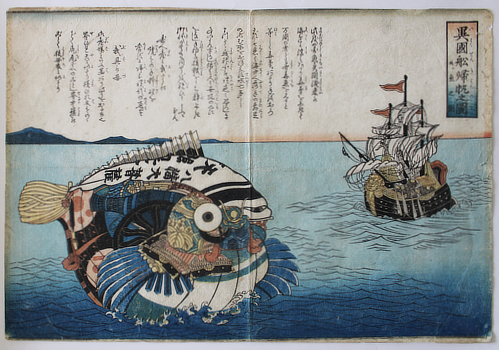
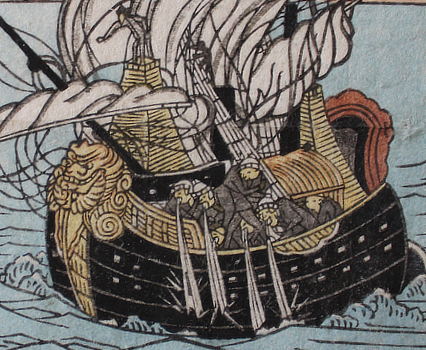
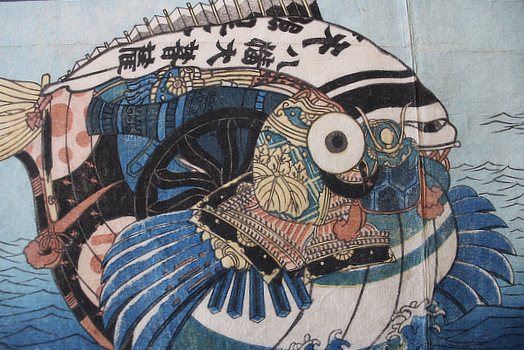
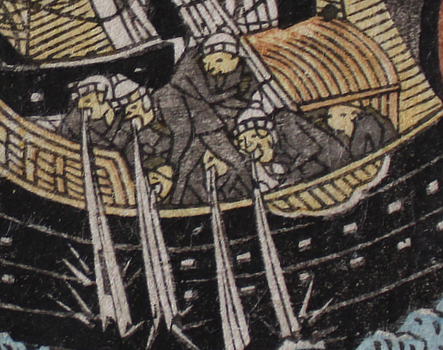
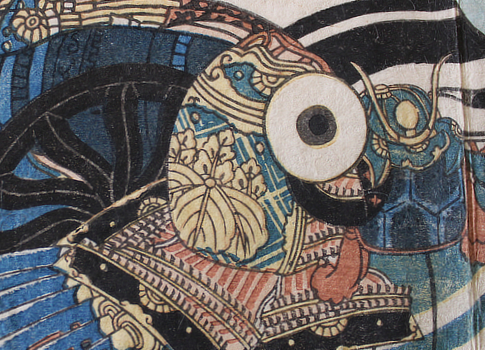

Best Yankee Go Home banner ever
Perry and the black ships 異国船帰帆之図 [Ikokusen Kihan no Zu]. n.p. n.d. [1853-54]. 24x34cm colour woodcut. Old folds and some rubbing round the edges; a couple of tiny pinholes; rather good with pleasing colour. Au$6000
Fabulous, in both senses of the word, rare, and satisfyingly baffling. Even with some help from the accompanying poetry this print defies comprehension. It can only be explained with surmises. Starting with the title which can translate as Foreign ship returning home, who can explain why the ship is sailing towards the astounding fish that is Japan and why the look out is pointing that way? A reasonable guess is that artist couldn't find a better old ship print to work from, the picture works better this way, and the rest is unimportant detail. Why the important men are vomiting over the side we will soon learn.
That fish - fugu - pufferfish - exists by itself in another print, Fugu no Zu, a surimono like print that is known by the copy in the Tokyo Metropolitan Library in one of the volumes compiled by Mokitsu Hachiya. Mokitsu was a Tayasu Tokugawa official and writer.
Some of the same text appears on both. Which print came first seems unknown. The fugu on its own seems likely but, while very similar, our fish is more carefully detailed, usually a sign of the original. What is certain is that both prints appeared between Perry's first visit in July 1853 and his return in February 1854.
The first line of text on the fugu's back reads Hachiman Daibosatsu - Hachiman Great Bodhisattva. By this time Hachiman had evolved from being a god for farmers and fishers to being a god for samurai. That fugu is a floating armory: weapons, armour and regalia, including the crests of three clans defending japan on Odaiba, the artificial island near Shinagawa. Just the sight of that poisonous puffer has sickened the Americans and sent them rushing home, backwards, for a home cooked meal. I think that's what some of the text suggests.
As far as the text on the print goes I would have a better chance of choreographing a dance from it than reading it. I suspect the modern Japanese reader is also stumped by the poetic allusions and puns: the few notes I have found either miss the point or don't attempt to explain it. It is satirical but is it satirising only the Americans fleeing Japan as all unwelcome foreigners before them? Is it also satirising Japan's defenders, the massed clans around Tokyo harbour? Would they be pleased to be a fugu? Is this why the print is so decidedly anonymous?
This has been called a kawaraban which I think breaches the spirit of what a kawaraban is: a cheap illicit news sheet for sale on the streets; but I won't make a fuss about it. I've traced three copies: Tokyo university in a collection of satirical prints before and after meiji - they date it to 1864 but that must be the date of the collection, not this print; Stanford copy in an album of drawings and prints relating to the black ships and foreigners; and a copy in the Rijksmuseum Volkenkunde, Leiden.
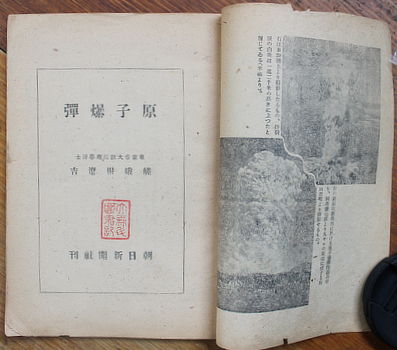
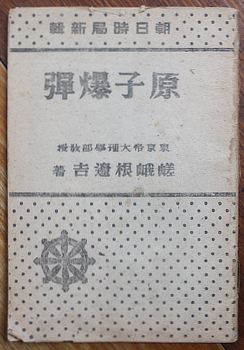


Uncensored
Sagane Ryokichi. 原子爆彈 [Genshi Bakudan (ie: Atomic Bomb)]. Tokyo, Asahi Shinbunsha October 1945 (Showa 20). Octavo, publisher's printed wrapper; [6],58pp including wrapper, photo illustrations and diagrams. Expected browning of the cheap paper and trivial chips and tears to the wrapper; pretty good for such a vulnerable thing. As yet undeciphered seal on the title.
With pages 37-40 that were removed before issue, supposedly from all copies. These are the sections, "Genshi bakudan to Nihon" and "Genshi bakudan no koka" - the atomic bomb and Japan, and the effect of atomic bombs. Copies were dismantled and roughly side stapled after those pages were gone. Au$2000
About a hundred years ago I decided that collecting the pamphlets and ephemera published round the world in 1945 on the atom bomb - first response so to speak - would be fun and profitable. It took me a while to discover there was anything published in Japan. For some time I found nothing in any library catalogue and that, I thought wrongly, made sense. The one people unable or unwilling to rush into print would be the Japanese after August the 6th. Then I came across a mention of a booklet by Takeo Takei and this one by nuclear physicist Sagane Ryokichi.
This is exactly as it should be: unassuming, printed on cheap newsprint stock with diagrams, blurry and uninformative photographs and, best of all, censored after printing.
Sagane was the recipient of the letter from physicist Luis Alvarez and two other former colleagues that was dropped in a canister over Nagasaki a minute before the bomb. The letter in part reads, "We implore you to confirm these facts to your leaders, and to do your utmost to stop the destruction and waste of life which can only result in the total annihilation of all your cities, if continued. As scientists, we deplore the use to which a beautiful discovery has been put, but we can assure you that unless Japan surrenders at once, this rain of atomic bombs will increase manyfold in fury."
Worldcat now finds two copies outside Japan - one in the Prange collection of occupation material. That copy is marked 'Deleted' in English and Japanese on the cover with the page numbers. The other copy is also, I assure you, censored. The twist that the US occupation censors added that made Japanese writers and publishers wish for the good days of home made tyranny was that censorship itself was forbidden. That is, a publisher could not just blot out any offensive passages; all signs of censorship had to be removed which often meant a complete rewrite and reset.
It is an immutable law of bibliography that whenever every copy of a book is censored then an uncensored copy must exist. Here is the proof of that law.
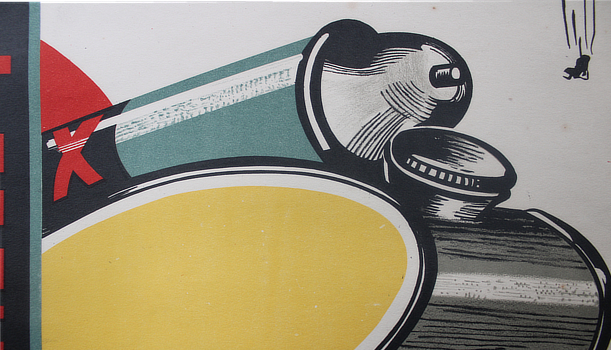
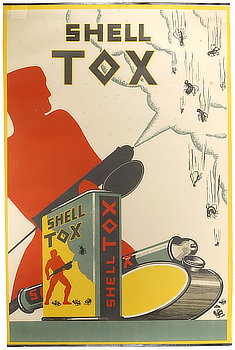
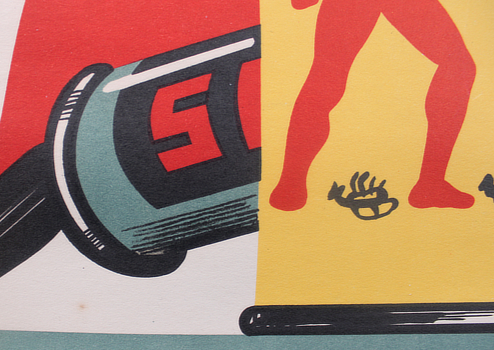

Japanese poster. Shell Tox. n.p. 193-? 77x50cm colour lithograph with metal strips top and bottom and hanging loop at the top. A nice copy. Au$475
Heavy weaponry has been brought in for Japan's war with bugs: that spray pump is no longer a gun, it's a tank. The stalwart armed figure appears everywhere in Shell Tox advertising around the world but that rampant tank seems peculiar to Japan. This is a shop poster with hanging strips. It's on better paper than usual: many Japanese lithograph posters are on heavy paper like this but are liable to become brown and brittle.
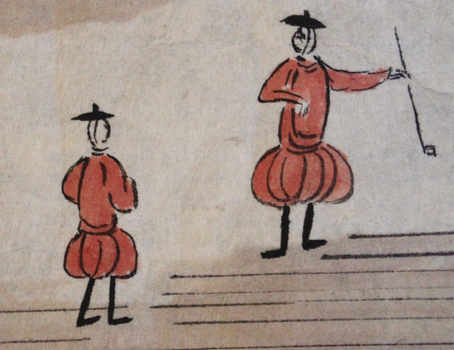

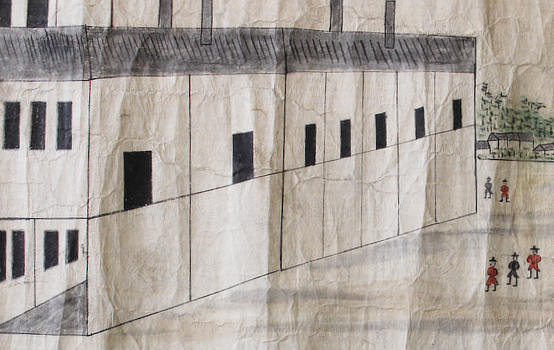
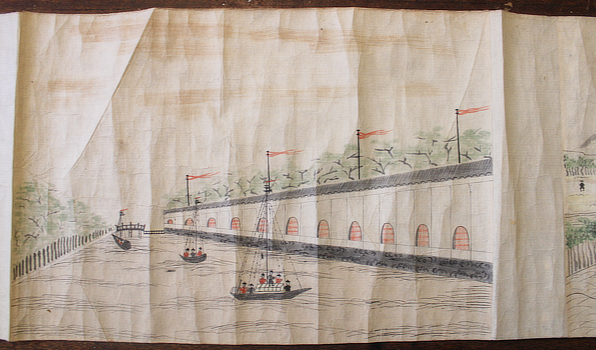
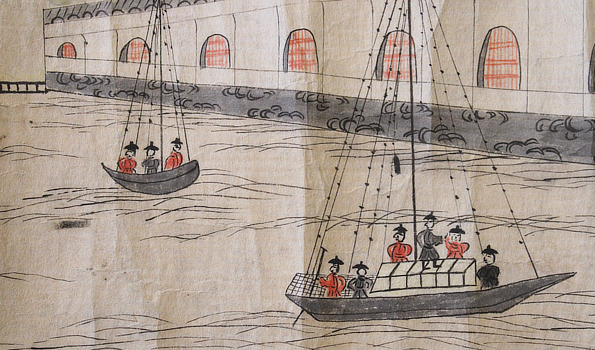

Dutch whispers ... duck's whiskers
Japanese scroll - views of Holland. 阿蘭陀眼鏡之絵 [Oranda megane no-e] n.p. n.d. (18th or early 19th century). 245x29cm, ink and colour on paper. Blank lead in stained and chewed with stains along, and a piece from, the bottom edge of the first view; rumpled. Five scenes each 38cm wide with blank spaces joined between each. Au$2750
This is what anglophones like me, with characteristic sensitivity, used to call Chinese whispers. I've chosen to call this scroll Dutch whispers: a perfect example of a landscape imagined from second hand - at best - reports. No-one in direct contact with a Dutch trader in Nagasaki would have able to walk away with these views uncorrected. Perhaps more telling is that our artist had scant access to European engravings which were being passed around select circles by the end of the 18th century. They may have seen late 16th century Japanese paintings of the Portugese or those breeches were passed down as oral history. Our artist never got near Nagasaki, saw anyone Dutch, or knew anyone who had.
Oranda megane literally translates as Hollander glasses or spectacles, no-e just means picture. So does this mean that the viewer can see the world as the Dutch see it?
This is no child's drawing. Neither is it the work of a great artist. But it is by someone who was, at least, well trained with a brush. Often reports and drawings of foreign doings were recorded and copied by scribes for circulation among officials and the well connected. But any educated person was expert with a brush. This looks more personal, maybe even fun give the possibly poetic title, than anything official. It has the essentials: dikes and canals, windmills, massed colonades, multi storey buildings and tall chimneys ... too many hills and mountains but how could any Japanese picture somewhere as flat as Holland? So a fair bit of detail, all the important stuff, has been gathered, digested and incorporated into these views of the Dutch home planet.
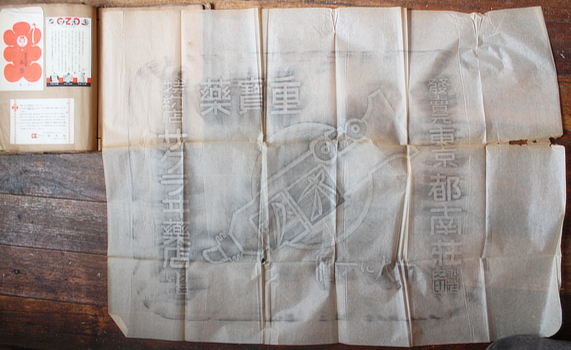
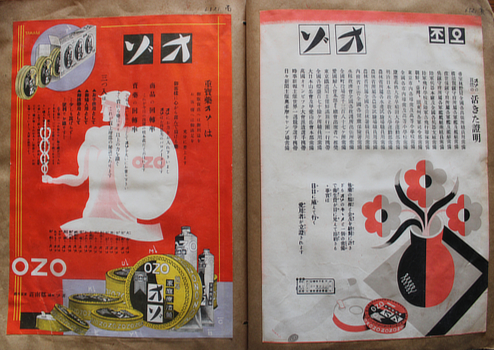
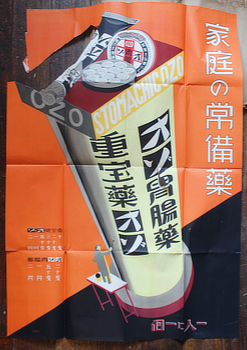
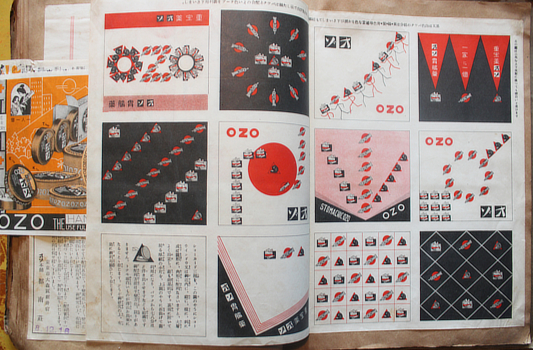
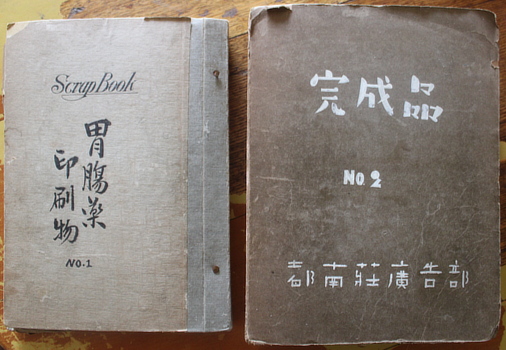
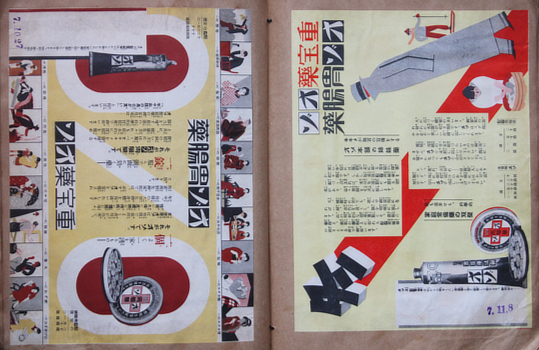
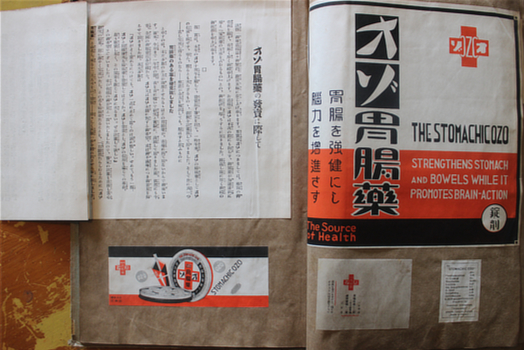

Ozo. Tonanso Kokoku-bu. Two albums with mounted examples of advertising, packaging, pamphlets, posters, stationery, etc, etc, etc, from the Tonanso Advertising Department. v.p. 1931 to 1934. Two card albums 30x23cm, lettered by hand and numbered 1 and 2; each bulging with mounted examples. 1: 35 leaves, removal from one page. 2: 89 leaves, removal from one opening and one leaf, a couple of other items with some damage, some of it purposeful, eg a piece clipped from each of the large posters. Binding pins of the first album separated by the strain of the heavy cardboard boxes. Au$3000
A wondrous collection; it even includes a full size rubbing of a carved kanban - shop sign - on drafting tissue (94x68cm). This is an education in just how much design, printing and paper engineering goes into getting your product into every home in the country. From the seals that go on packets to letterheads, to promotional postcards, through to a couple of large posters (94x62cm) and that kanban. And packets, packages, boxes ... With these albums you could have Stomachic Ozo back on the market in no time.
Tonanso was the parent company of Ozo - an ointment for every skin, every surface, malady ever suffered by humankind - and Stomachic Ozo which likewise cured every internal malady. Ozo for skin is still made, by another company. Though it now only cures a handful of skin problems, I read somewhere that it still has diehard fans despite the drawback of staining clothes. Almost needless to say: the packaging and advertising are dull dull dull.
From what I can find out, which isn't much, Ozo ointment went on the market in the mid twenties. The current makers have cut any connection with quackery in the past and give no history of their product.
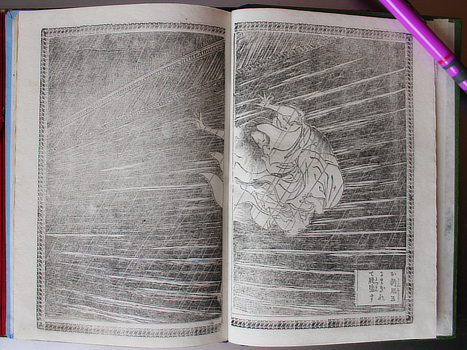
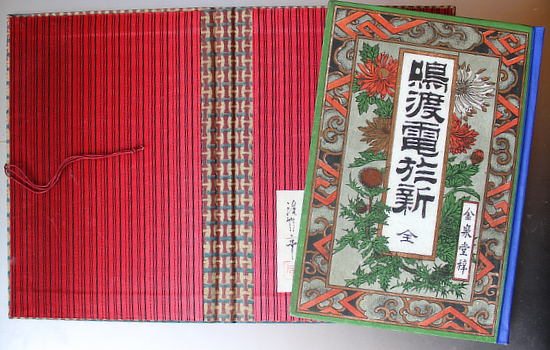
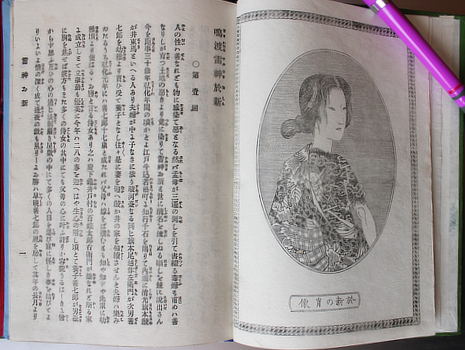
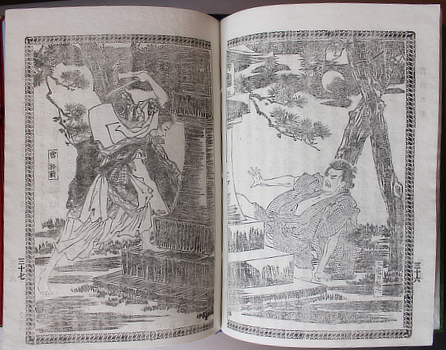
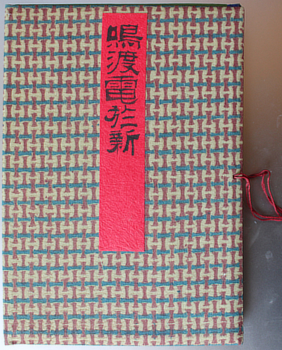

The tattooed woman outlaw
Ito Kyoto. 鳴渡雷於新 [Naruto Kaminari Oshin ?]. Tokyo, Kinsendo 1886 (Meiji 19). 18x12cm publisher's colour illustrated boards with cloth spine; four illustrations, three double page. A fabulous copy in a chic case by binder, writer and fastidious collector Atsuo Ikuta. Au$500
This might appear to be the first edition but it turns out that an edition appeared in 1883 from a different publisher with different illustrations. This is the story of the tattooed woman desperado Kaminari (or Rai?) Oshin - Naruto Kaminari might translate as roaring or raging thunder.
This immediately reminds us of Benten Kozo Kikunosuke - the tattooed woman outlaw who was outed as a man when a glimpse of her tattoos was seen; Benten was the star of kabuki plays and novels. That story hinged on the premise that no woman would be tattooed like that.
Of course this is the true story of a real person and there's no question that our heroine is a heroine. Nor that she's tattooed. On her back is Keisai Eisen's Hojo Tokimasa; on her buttocks is a dragon; on her thighs is a picture of Iwami Jujiro slaying a giant snake; on her stomach is one of the heroes from "Suikoden", Kumonryu Shijin; on her right arm is Kintaro; and on her left arm is a portrait of four people. A photo exists of what is supposed to be her skin which, in accord with her will, was tanned. It was exhibited in the Taisho period but has since been lost.
She was supposedly still alive and maybe in prison when this book appeared. She had been sentenced to life imprisonment in 1874, escaped in 1882 (see the explosive illustration), was arrested again and pardoned in 1889. She died, probably of TB, the next year, age about 40.
Worldcat finds no copies of this book. Cinii finds four entries for the 1883 edition in Japanese university libraries but not this.
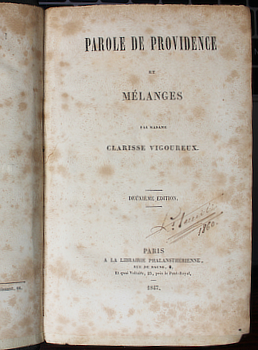
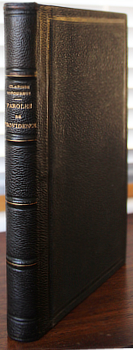


VIGOUREUX, Clarisse. Parole de Providence et Melanges. [bound with Victor Considerant's Du Sens Vrai de la Doctrine de la Redemption. 3e edition]. Paris, Librairie Phalanstherienne 1847 & 1849. 12mo (19x13cm) morocco backed cloth; [4],128pp & viii,90pp. Generally foxed. Au$275
Second edition of the Parole de Providence with added writings including the Resurrection. Aux Femmes de France. 1846. The first edition appeared in 1834. This was her only book - a Fourierist response to Lamennais' Parole d'une Croyant - but she was a busy journalist for the cause. Her book won a place in the Index and her censor, the Jesuit Zecchinelli, decided that Clarisse Vigoureux was a fictional front for Fourier himself. The book presented, Zecchinelli wrote (here in rough translation), 'An absurd, impious, carnal, diabolical system, which limits itself entirely to the present life and makes men lose hope of the future good to which they are destined in heaven'. He uses the pronoun 'he' for the author all the way through his critique. He is, Philippe Boutry tells us (The Roman Condemnation of the First French Socialism), silent on Clarisse's feminist claims: "I, a woman, have come to demand an account ... I demand an account from the stronger sex that rules the world, and for three thousand years has kept it chained in this inextricable maze." This from the prologue, and there is a chapter on women.
Victor Considerant might have made the apocryphal claim to Fourier that Fourier having created a universe, he, Considerant, would populate it. And he did to an extent that few other utopian socialists of the time could. Considerant was a school chum of Clarisse's son Paul, from that he met Clarisse at the centre of the then small circle around Fourier, and from that he met Fourier's ideas, Fourier himself, and Clarisse's daughter Julie.
I wonder how much the life long devotion and self sacrifice of Clarisse and Julie had to do with Considerant's retreat from Fourier's ideals of the emancipation of women. Was he a spoilt brat? And was God against her? She lost her husband and her first daughter young, lost her fortune when her brother's company went down, lost the revolution, lost the societaire settlement in Texas where she accompanied Considerant and her daughter after his exile and finally, Boutry tells us, the flower garden she planted in front of Considerant's home in San Antonio where she died was eaten by red ants.
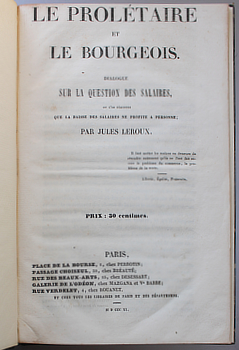
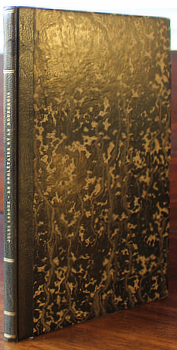

LEROUX, Jules. Le proletaire et le bourgeois. Dialogue sur la question des salaires ... Paris, Perrotin &c 1840. Octavo modern quarter morocco and mottled boards; 32pp. Trimmed a bit close at the top, an excellent fresh copy. Au$125
While older brother Pierre was the philosophical centre of socialism, he claimed the word as his, it seems universally accepted that Jules was the economic brain in the mix.
Like so many of his troublesome contemporaries he ended up in exile, first in Jersey then in Kansas where he established the settlement New Humanity. He didn't stay long and from Neuchatel - still in Kansas - he published the newspaper L'Etoile du Kansas, to me one of the more beguiling titles I've come across. Sounds like it belongs in a Weill/Brecht opera. In 1880 it was on to California and a new community, Icaria-Speranza, where he died in 1883.
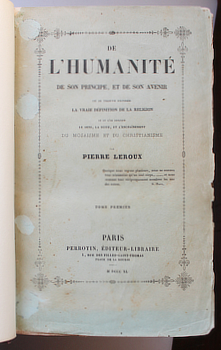
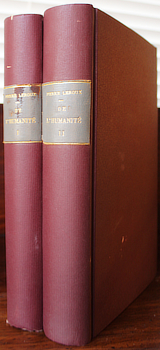
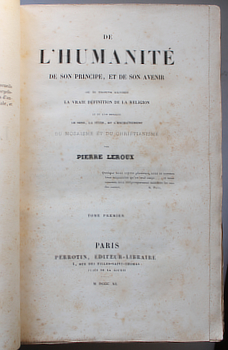

LEROUX, Pierre. De l'Humanite de son Principe, et de son Avenir ... Paris, Perrotin 1840. Two volumes octavo, uncut in modern boards, original wrappers preserved. Adhesion spots on the inner margins of the wrappers, suggesting it has been in a couple of binding; general foxing but not too strident. Au$200
First edition. Leroux eagerly dove into the Saint-Simon pool with Enfantin and Bazard, writing what became the manifesto of the group. He climbed out again quite soon, disillusioned with bourgeois individualism; no two zealous reformers can stay in the same water for long. Sometimes those groups ruptured and splintered so explosively it's hard to see how each came out with their own body parts. In a way he was the first socialist: he claimed the word socialisme was his.
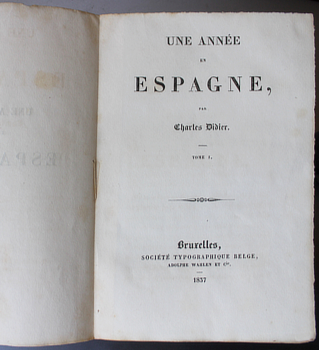
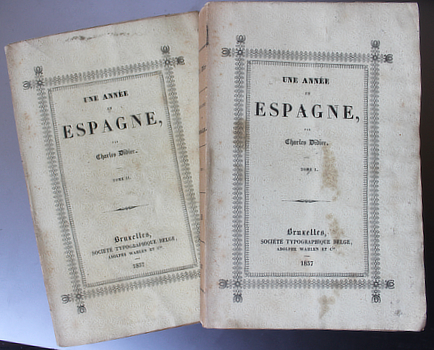
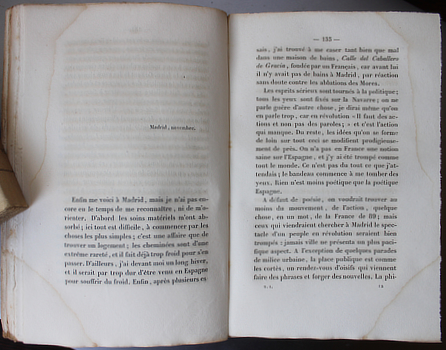

DIDIER, Charles. Une Annee en Espagne. Brussels, Societe Typographique 1837. Two volumes 12mo, publisher's printed wrappers. A tidemark in the margins of a fair slab of the first volume, taking the shine off what would be a rather good copy. Au$100
This came with a collection of French utopians, socialists and troublemaking feminists and I wonder why. He may well report on social and political troubles and the work of utopian socialists in Spain but without reading the book (and I won't) the closest I can get is that he was one of George Sand's lovers and failed to excite the French about Giacomo Leopardi long before St Beuve succeeded. Having Leopardi die young in the meantime must have helped St Beuve. Didier started out as a Swiss poet and went on to a handful each of novels and travel books.
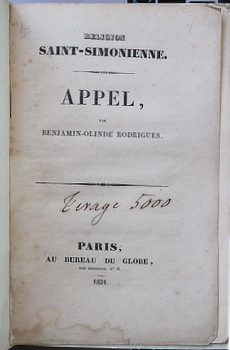
RODRIGUES, Benjamin-Olinde. Religion Saint-Simonienne. Appel, Paris, Bureau du Globe 1831. Octavo 16pp, in modern plain card wrapper. Nonfatal stain in the bottom edge. Inscribed on the title is 'Tirage 5000'; surely the number of copies printed, not a claim that this is the 5000th printing. Au$150
Rodrigues was that horror of every anti-semite, a Jewish banker. He was also a mathematician with his own formula and a small but growing group of modern champions pointing out his ignored work, later discovered anew by others and honoured. But that's not important here. After Saint-Simon's death in 1825 - he had been supported by Rodrigues in his final miserable years - Rodrigues and his former student Enfantin became joint partners in running the business, so to speak. Of course they ruptured and in 1832 Rodrigues claimed he was the true apostle. It didn't work so well; he has largely disappeared from the history of the movement.
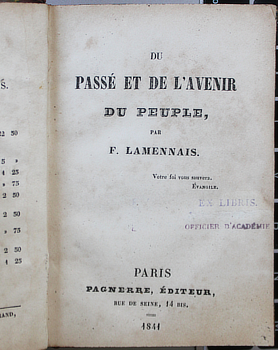
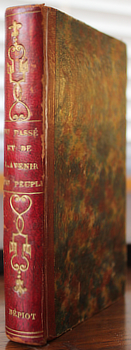

LAMENNAIS, F. [Felicite]. Du Passe et de l'Avenir du Peuple. Paris, Pagnerre 1841. 32mo red gilt calf backed mottled boards. A bit of browning. A small partly erased ownership stamp on the title page and the name Depiot at the base of the spine; likely Joseph Depiot of Gascony who's of no particular interest that I know of, except that he owned this and wrote a poorly thought out ode to liberty. Au$165
First edition, written in prison where he was serving a year's sentence for his Le Pays et le Gouvernement of 1840. A proper renegade priest, Lamennais started well, earning the approval of Leo XII and even the offer of a cardinal's cap. By 1833 he had turned nasty and renounced all connection with the church. 1834's Parole d'un Croyant earned him what must have been one of the speediest encyclicals ever issued. And the ire of Clarisse Vigoureux. After the 1848 revolution he drew up a draft constitution which was apparently rejected for being too radical.
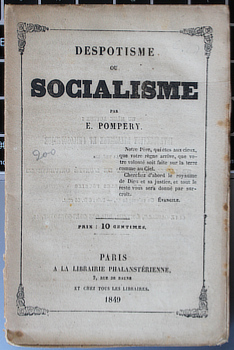
POMPERY, E. [Edouard de]. Despotisme ou Socialisme. Paris, Librairie Phalansterienne 1849. 17x11cm, folded but not cut or stitched; ie it is still one sheet of paper printed on both sides forming 32pp. Au$100
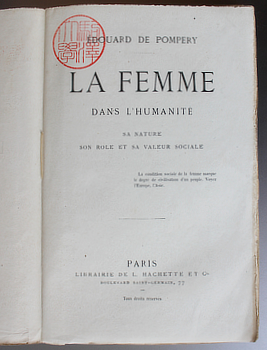
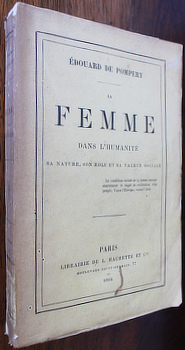

POMPERY, Edourd de. La Femme dan l'Humanite : a nature son role et sa valeur sociale. Paris, Hachette 1864. Octavo publsiher's printed wrapper (spine top chipped, signs of a label removed fom the spine). Red Japanese ownership seal on the title page. Au$150
First edition of the Fourierist's feminist manifesto. He appears to have been a friend of Flora Tristan and George Sand, which must have taken some delicate footwork. Sand urged that Pompery marry Flora's daughter Aline rather than waste his time building a tomb to that madwoman (cette folle de Flora).
I wonder if many modern feminists will stomach Pompery, what with him likening a woman to a beautiful rose that needs careful cultivation. But he may have someting more sensible to say.
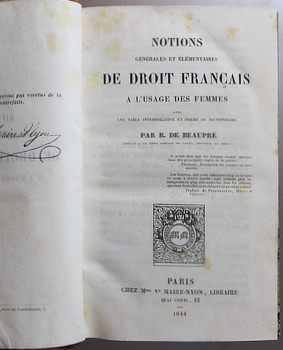
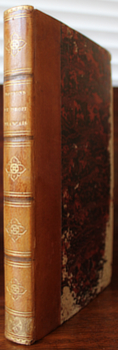

BEAUPRE, B. de Notions Generales et Elementaires de Droit Francais a l'Usage des Femmes ... Paris, Mme Ve Maire-Nyon 1844. 12mo calf backed mottled boards (paper surface nibbled by bugs). A few light spots, pretty good, with the bookplate of de Rambuteau - Claude-Philibert Barthelot, prefect of Paris in the 1830s and 40s, the man who gave Paris the pissoir. Au$100
First edition. This didn't have the success predicted by Delphine de Girardin, in one of her Parisian Letters: "Mr. de Beaupre has just published a very interesting book entitled: General and Elementary Notions of French Law for the Use of Women. This work, quite timely, is destined for the greatest success. In France, the future of business belongs to women. Men, dizzy, sleepy, stupefied by the immoderate use of tobacco, will soon no longer be in a position to occupy themselves seriously. In fifty years from now, women will be at the head of all businesses, administrations, banking houses, etc., etc.; they already direct all political affairs surreptitiously; in fifty years, they will conduct all industrial and administrative affairs openly;" But, then again, neither did women.
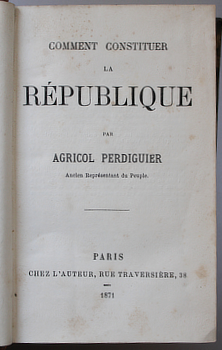
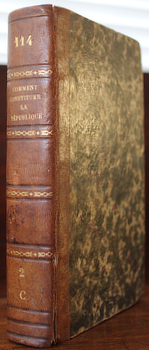
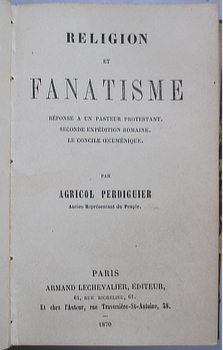
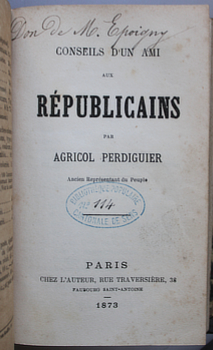

PERDIGUIER, Agricol. Comment Constituer la Republique. [and] Despotisme et Liberte. [and] Religion et Fanatisme. [and] Conseils d'un Ami aux Republicans. [and] Les Gavots et les Devoirants ... [and] Patriotisme et Moderation. Paris, all but one by the author 1862-73. Six works together, without whatever wrappers they may have had, in calf backed mottled boards (16x11cm,front hinge cracked but joint firm). Varied browning depending on the paper, nothing serious. With stamps of the Bibliotheque Populaire, Cantonale de Sens, gilt shelf number on spine, and each inscribed Don de M. Epoigny. Unfortunately Epoigny is a common name in Sens. Au$350
Radical republican, carpenter and fervent compagnonist (what would become a trade unionist), Perdiguier was elected to the assembly in 1848 and booted out of the country after Napoleon's coup in 1851. Returning to France a few years later he opened a small bookshop, a sure sign of impending destitution. Once championed by George Sand, praised by Sue, Pierre Leroux, Hugo, Lamartine etc etc, and supposedly given a send off by a huge crowd at Pere-Lachaise when he was buried he indeed died destitute in 1875.
What's collected here is all from his bleak later life, all self published.
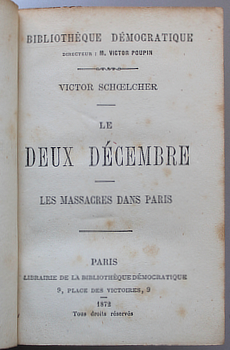
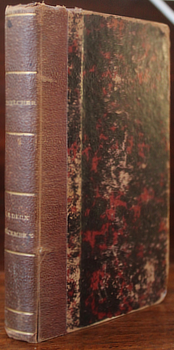

SCHOELCHER, Victor. Le Deux Decembre - Les massacres dans Paris. [with] Le Crime de Decembre en Province. Paris, Bibliotheque Democratique 1872 & n.d. 16mo, Together in cloth backed mottled boards (boards rubbed and worn at corners). A bit of spotting in the first work, even natural browning in the second. Au$65
Schoelcher was a life long do-gooder, starting with the abolition of slavery in 1848. He is said to be one of two assembly members on the barricades during Bonaparte's 1851 coup and wrote his histories of the Decembre crimes from exile. Given the size of those books, the speed with which they were published and the sheer mass of names and dates I can only guess that he went into some eidetic trance and dictated non-stop everything he saw and heard while a team of stenographers scribbled furiously.
In the wake of 1871 Victor Poupin's Bibliotheque Democratique has, with Schoelcher's blessing, published these extracts in a cheap popular form. The history of these little books is confused with varied claims about their originality and first appearance which aren't right.
Meanwhile Schoelcher carried on as a left wing senator, working for women's rights and the abolition of capital punishment.
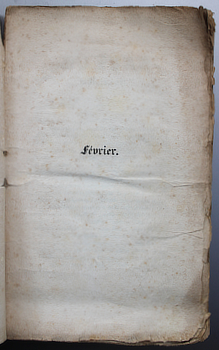
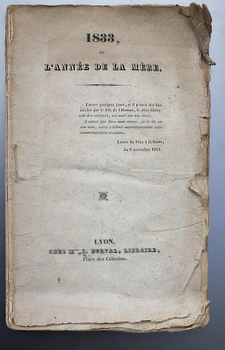
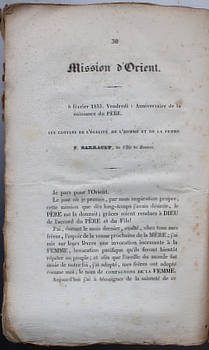
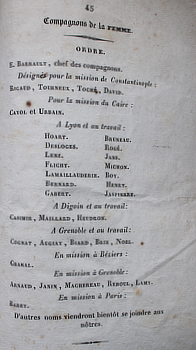

Compagnons de la Femme. [Emile Barrault]. 1833, ou l'Annee de la Mere. Lyon, Mme S Durval [1833]. Octavo, side stitched; 48pp. Title rather ragged and dusty, dog-eared. A tired copy but worth preserving. Au$150
Probably the second of maybe four issues of this rare work. This is titled February on the leaf after the title; others known to exist are January and two more with different titles that apparently appeared in June and July. One of the more loopy, to be polite, excursions of the Saint-Simonians: a group formed themselves as the Companions of Women and set off to find a prophesised female messiah in the middle east. If nothing else it allowed them to ignore all and any women at home.
Father Enfantin intervened and got them to work building industry and railroads and colonising north Africa.
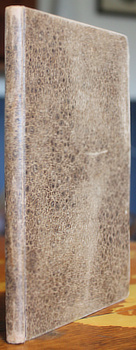
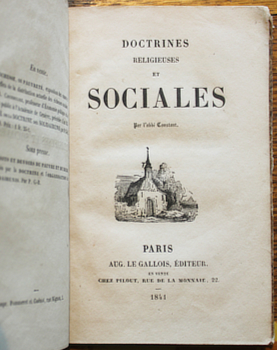

CONSTANT, l'abbe [Alphonse; later to be Eliphas Levi]. Doctrines religieuses et sociales. Paris, Le Gallois 1841. 12mo later marbled boards (a bit rubbed). Some minor signs of use, light pencilling, a bit of browning. Very acceptable. Au$300
First (only?) edition. Don't be fooled, this may be dressed in a Christian cassock - Constant never reached the rank of abbe in the church - but it is dangerous radical, socialist, heretical stuff. I think this is his third book, coming between his Bible de Liberte (for which he was arrested) and Assomption de la Femme and the emancipation of women is a chapter here. I'm not sure any modern feminist would be happy with his view of women but he was trying hard. As he had to, being one of the inner circle of devotees of Flora Tristan. He published her l'Emancipation de la Femme, ou le Testament de la Paria in 1846, two years after her death.
He drifted into magic in the 1850s after an action packed but disappointing decade for revolutionaries. And like many mystics and magicians, Constant/Levi seems to have published more after his death than he did alive.
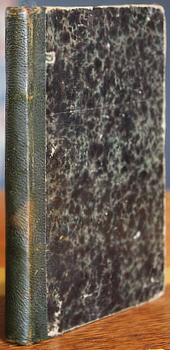
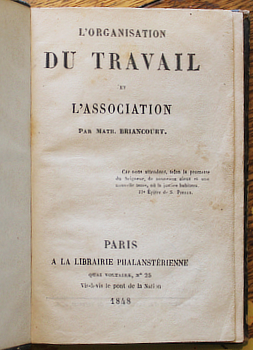

BRIANCOURT, Math. [Mathieu]. L'Organisation du Travail et l'Association. Paris, Librairie Phalansterienne 1848. 13x9cm contemporary roan backed mottled boards (rubbed); 8pp catalogue of the Librairie Societaire at the end. Au$80
I'm pretty sure these are the sheets, with a new title page, of the second printing published by the Librairie Societaire in 1846; the first edition appeared in 1845. They might have used standing type or stereos but I doubt it. There were fairly speedy German and American translations.
This is dangerous rabble-rousing socialist stuff in the wake of Fourier. There is a photo of an old Briancourt online but it could be any flint-hearted stubborn old Frenchman. He was a dedicated and dogged Fourieriste until the end.
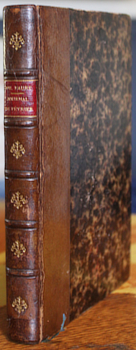
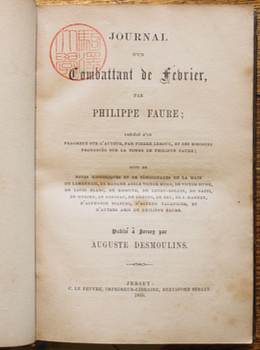

FAURE, Philippe. Journal d'un combattant de Fevrier ... notes historiques et de temoignages de la main de Lamennais, de Madame Adele Victor Hugo, de Victor Hugo, de Louis Blanc, de Kossuth, de Ledru-Rollin, de Saffi, de Herzen, de Berjeau, de Greppo, de Bru, de J.Harney, d'Alphonse Bianchi, d'Alfred Talandier, et d'autres amis de Philippe Faure. Publie a Jersey par Auguste Desmoulins. Jersey printed by C. Le Feuvre 1859. 18x12cm contemporary half calf (a bit rubbed) and mottled boards. Red Japanese seal on the title page; some browning but nothing serious. Au$165
Yet another troublesome Frenchman of the 1840s. This is Faure's journal of fighting on the barricades in 1848. He turned journalist after this and caused even more trouble, winding up in exile in London and Jersey after a failed insurrection against Louis Napoleon's 1851 coup. His friend Desmoulins published this, augmented with contributions by a squadron of his illustrious fellow exiles after his death at 33 in 1856.
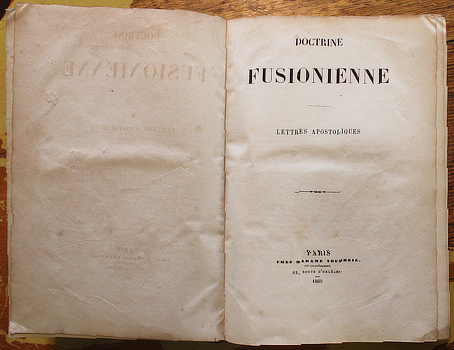
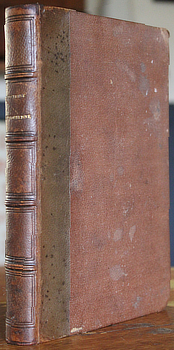
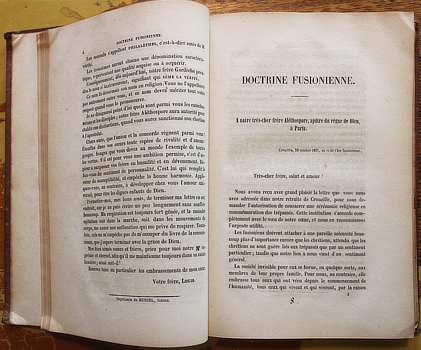
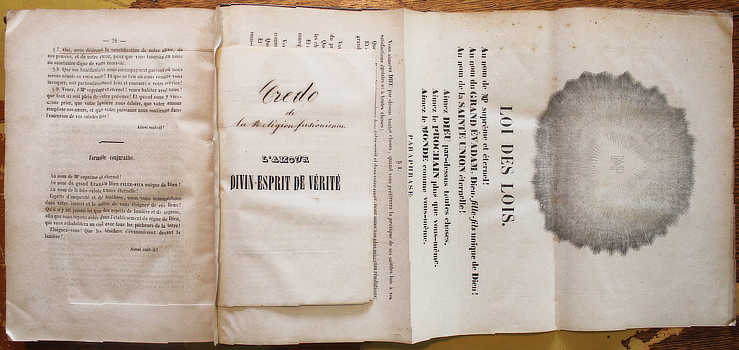

Not quite and more than complete
[TOURREIL, Louis-Jean-Baptiste de]. Doctrine fusionienne : lettres apostoliques. Paris, Chez Madame Tourreil 1860. [Various printers 1845 to c1861]. Octavo half morocco (rubbed, cloth marked). A compilation of separately printed items that range between four and 78 pages. Each letter numbered by hand so as to correlate with the table of contents and solve the problem of making sense of it all. Without letters 16 and 17 - see below. Signs of use but nothing serious: corners bumped, scattered browning; pretty good. Neat inscription of Jules Remy who may or may not be the naturalist traveller. The errata have been transcribed into the text in an equally neat hand. Au$500
From what I can figure out from skimming a few digested paragraphs, Tourreil's fusionism is a casserole of Fourier, Leroux, Saint-Simon, revelation and insect hives. A rich dish for academics in gender studies. He did have some disciples and they did more to propagate his utopian notions after his death than he managed.
This contains the collected title page and preface leaf for his Lettres 1 to 22 dating from 1845 on (but for 16 and 17), a table of contents, a 30 page analytic table, and an errata leaf for those 22 letters. Then come four more items: 1. Lettre ... a notre frere D....., de Bordeaux ... February 1861; 30pp; 2. Oraison Pleniere [... &c], undated; 28pp and a plate; 3. Credo de la religion fusionienne L'Amour Divin-Esprit de Verite; undated 12mo, 12pp, title partly in manuscript; 4. Loi des Lois; undated folding broadside with an engraving.
I found a description of a copy that apparently belonged to Gustave Mouravit which had all 22 letters and the four extra items, described by Mouravit as everything Tourreil published, without doubt unique. Claims by owners like this should be treated as dubious. The BN doesn't come up anything like all the letters but they do have something titled Religion fusionienne apparently written with Leon Galibert and printed in 1845
Our copy has 32 blank leaves where letters 16 and 17 should be. It seems clear that when the first owner bought his letters Madame Tourreil had run out of copies of those two but she did have what had been printed since. This often happens with compilations of separate items put together by the author.
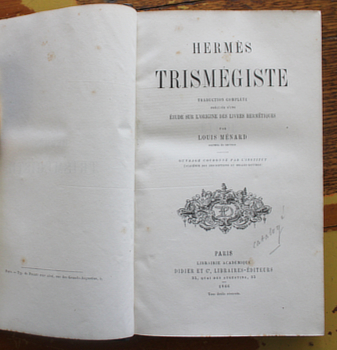
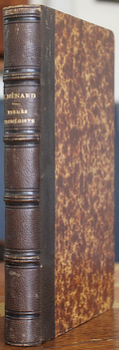

Louis Menard. Hermes Trismegiste : traduction complete ... etude sur l'origine des livres hermetiques. Paris, Didier 1866. Octavo quarter morocco and mottled boards. Occasional patches of browning depending on paper stock. Rather good. Au$200
First edition; there were a few more over the next hundred years. Menard was another of those damn French socialists of the 1840s, fleeing to London after 1848 to escape a prison term. He settled down eventually into a life of respectable mystic paganism and pedagogy.
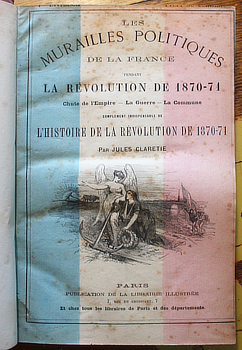
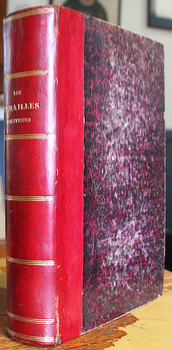
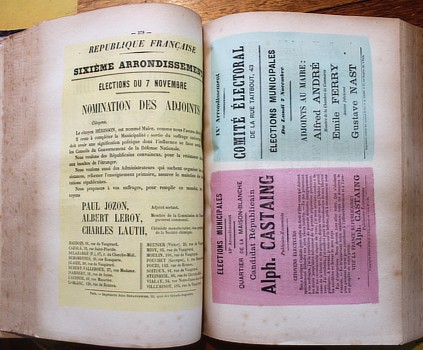
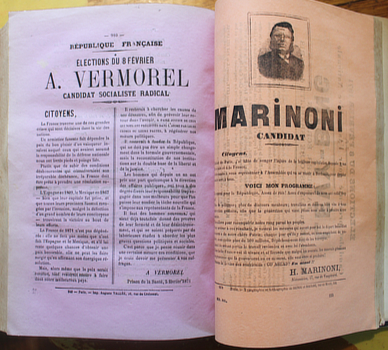
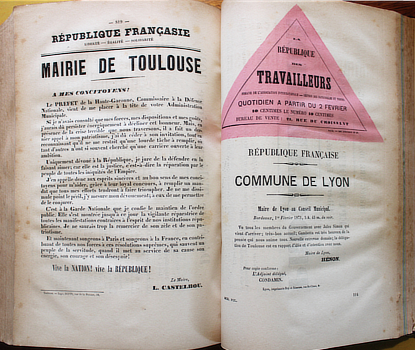

CLARETIE, Jules. Les Murailles Politiques de la France Pendant la Revolution de 1870-71. Chute de l'Empire - La guerre - Le siege de Paris. Complement indispensable de l'Histoire de la Revolution de 1870-71. Paris, Publication de la Librairie Illustree [187-?]. Hefty quarto quarter calf and mottled boards (some wear to edges); tri-colour title page; ii,1010 pages of examples and 12pp table of posters. Many posters or notices printed on colour backgrounds, a number printed on coloured papers. Some browning and spotting; pretty good. Au$275
The revolution, the war, the siege, the commune, as seen on the walls of Paris: the posters, proclamations, notices ... It is, as the title says, an indispensable complement to Claretie's five volume history of the revolution; I suggest the history is the dispensable part.
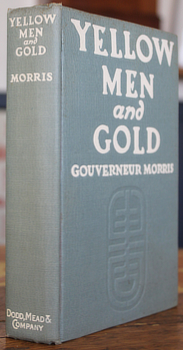
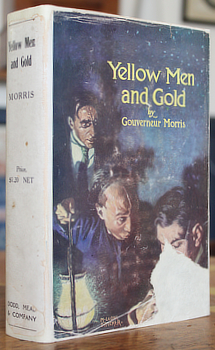
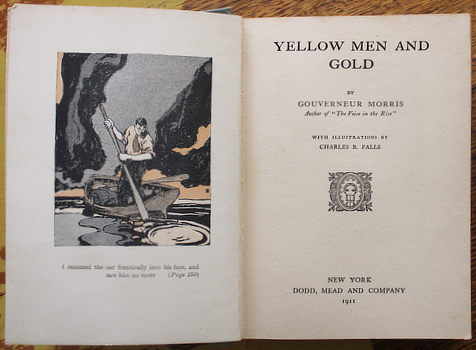

MORRIS, Gouverneur. Yellow Men and Gold. NY, Dodd Mead 1911. Octavo publisher's cloth blocked in white and blind; illustrated dustwrapper with a large piece gone from the front, professionally repaired by the look of it around the edges; six duotone plates, smaller illustrations by Charles Falls. A rather good copy. Au$300
First edition of this rip-roaring thriller in which the Yellow Men are not the malevolent peril but brave, stalwart and devoted to their elected captain Bessie who, it is suggested, has a touch of Africa in her veins. Still, despite the shocking reversal of roles in a thriller of the period, there's more than enough racism to go round. Or as any character might say, "Plentee dam lacist."
The wimp in glasses on the dustwrapper looks quite like Morris.
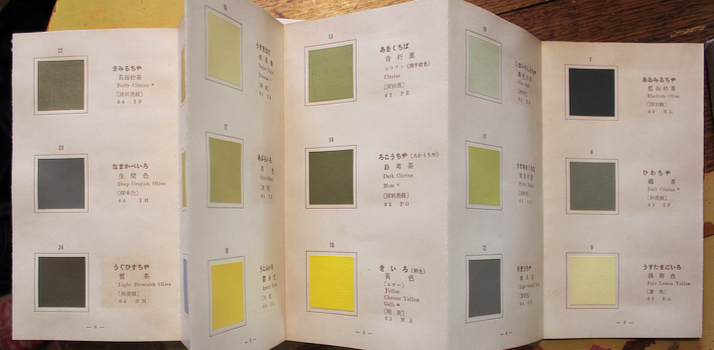
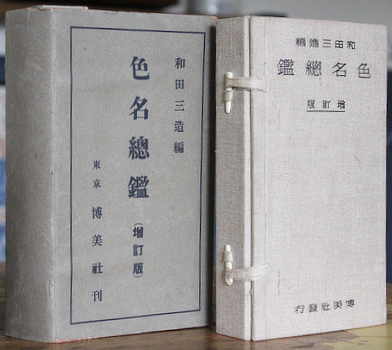
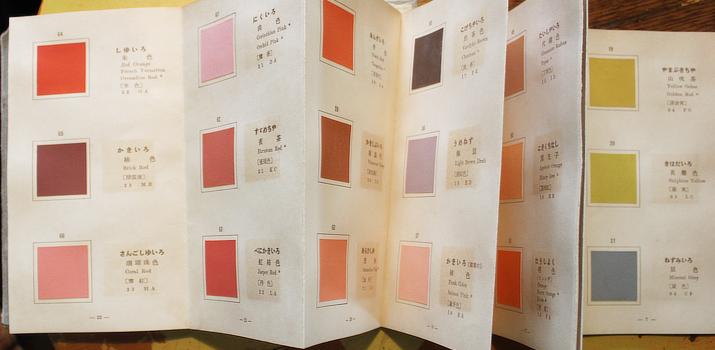
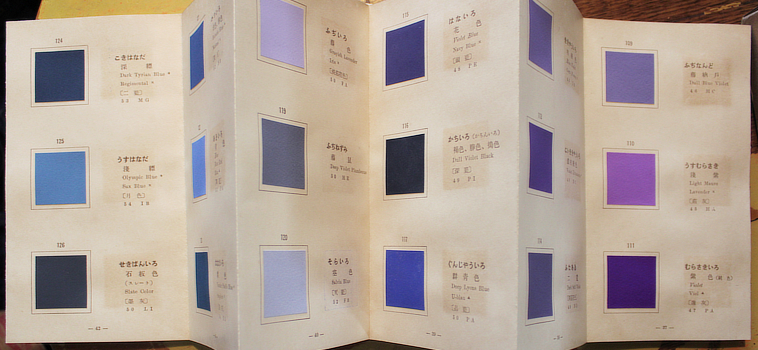
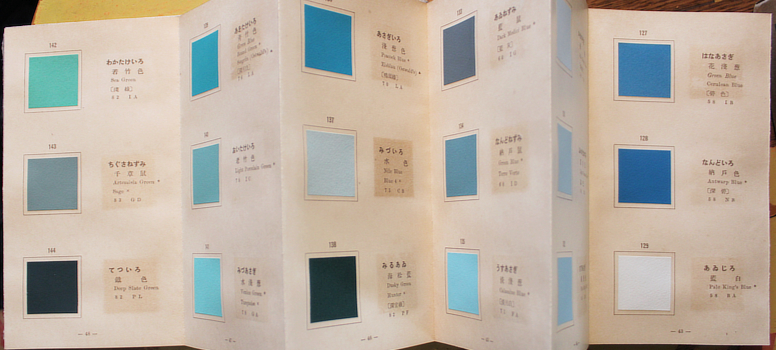

Wada Sanzo. 色名総鑑 (増訂版) [Shikimei Sokan (Zoteiban)]. Tokyo, Hakubisha 1935 (Showa 10). 19x11mm publisher's cloth case with 171 mounted colour samples on 57 accordian folding leaves; and card bound book; 182,8pp. Colour samples named in Japanese, English and occasionally French or German; table of multi language lists of colour names. Less than usual offsetting and browning despite what my photographs say, rather good in original printed card case with two folds repaired. Au$800
Second edition, enlarged and revised, of Wada's first serious attempt at colour nomenclature published in 1931. I can tell you there are a few more pages and eleven more colour chips in this edition. There seem to be significant changes in the text volume but I can't read them. Several colours have changed - that is the hue, tint or shade, not the name - and seem to this untrained eye to accord better with their names, though I would still pick an argument with his 'fawn'.
Wada, though at the top of the art ladder in Japan, insisted on pursuing new directions and founded the Japan Standard Color Association - now the Japan Color Research Institute - in 1927. In these early years science, art and aesthetics went hand in hand.
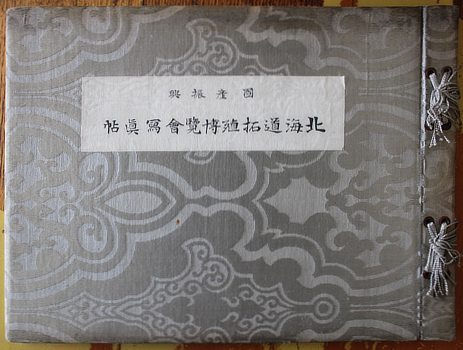
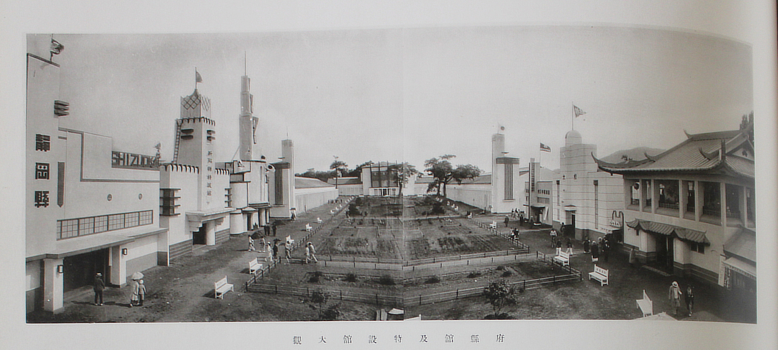
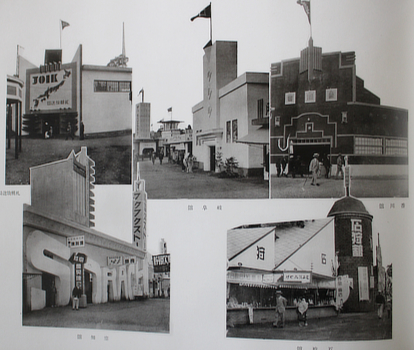
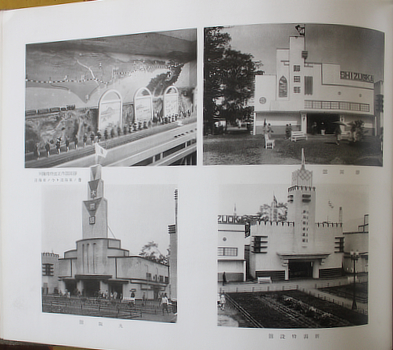
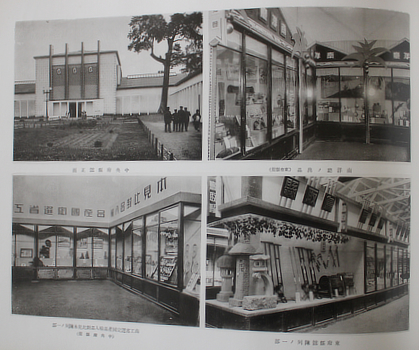

Exposition - Hokkaido 1931. 国産振興北海道拓殖博覧会記念写真帖 [Kokusan Shinko Hokkaido Takushoku Hakurankai Kinen Shashin Jo]. Hokkaido Takushoku Hakurankai, 1931 (Showa 6). 27x37cm publisher's patterned silk, cord ties (browning around the edges); title page, photo illustrations on 35 leaves of heavy gloss paper, 12 pages of text and a plan. Au$600
A luxurous celebration, with exemplary printing, of the 1931 Hokkaido Colonization Exposition. Had you heard of it before now? Me neither. Thankfully the important old men who always head such books don't take up too much space and it gets more interesting the further we go in. What's wonderful is the number of pavilions that might have come straight out of the pages of the exposition volume of the Gendai Shogyo Bijutsu Zenshu - the Complete Commercial Artist - of 1928-30. Either the same designers were at work or the organisers handed out copies of the book and said, "go for your life."
At the very end we find what seem to have been the big draws for the 600,000 plus visitors: the human cannonball, the world's fattest woman, and dancing girls.
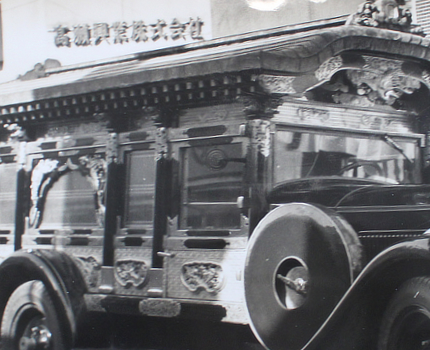
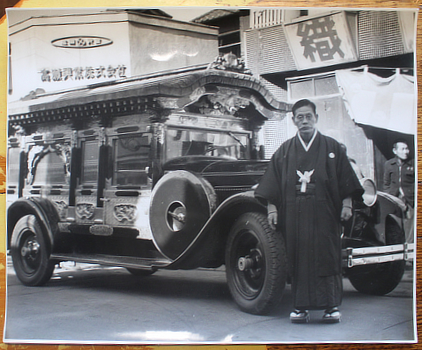
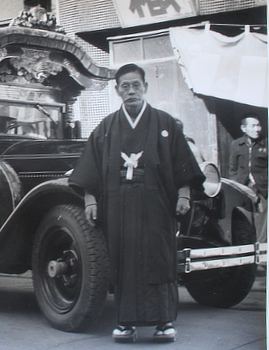

Hearse. Photograph of a gentleman and a fine Japanese shinto hearse - miyagata. mid c20th. 24x30cm photographic print. Au$80
Stop fretting over whether that man is on the wrong side of the coffin. Look at the hearse. I'd be proud to be carried to the furnace in that mobile shrine. After the advent of the car, as the 20th century drove on, the hearse devolved from the display case on wheels it had been to being little more than a stretch limo for the terminally lazy. Modern versions of these miyagata shinto hearses persist but they look like over-pimped slide on campers on the back of a ute.
I wonder about the location; it doesn't look a neighbourhood where many people would be able to afford this stylish a send off. But weddings and funerals are occasions for crippling expenses; it's only births that we skimp on.
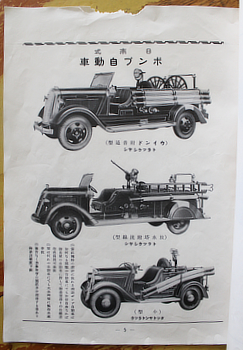
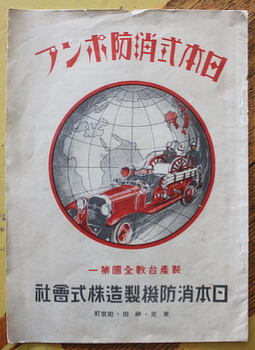

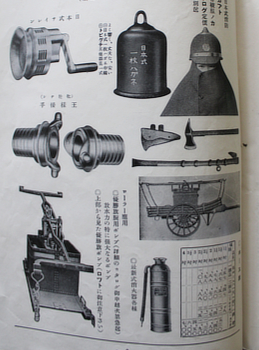

Catalogue - fire engines. Nihon shobo-ki seizo kabushikigaisha. 日本式消防ポンプ [Nihonshiki Shobo Ponpu]. The company 1932 (Showa 7). 26x19cm publisher's illustrated wrapper; 9 leaves printed on one side, photo illustrations. A chomp from the top edge. Au$150
A catalogue of proper fire engines. This is when the last fireman down the pole, struggling into his boots, tenaciously grips the last rung of the ladder as he flaps like a flag behind the speeding engine. There is as well as the standard engines, a nifty little run-about, a motor trike and some handy accessories.
Seems not much survives of the Japan Firefighting Machinery Co now but a few small pumps and a much prized three wheeler in fire museums. I found none of their catalogues in any library.
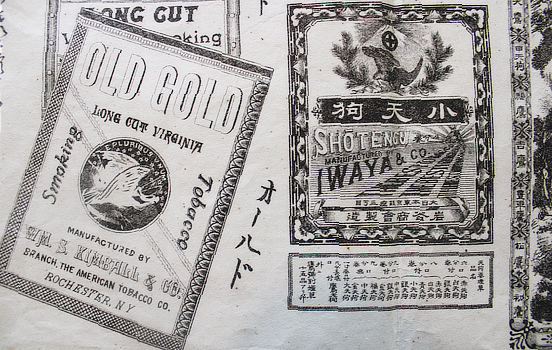
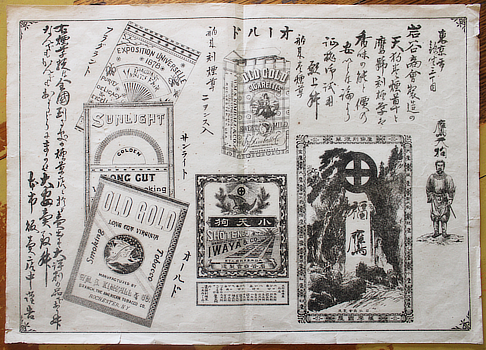


Tobacco hikifuda. Iwaya & Co. Hikifuda by Iwaya & Co for their Shotengu cigarettes and other brands from American manufacturers Wm. S. Kimball and S.F. Hess Tokyo? Iwaya c1890? 27x38cm illustrated lithograph. Folded and frayed around the edges; pretty decent. Au$100
Iwaya Matsuhei was a promoter's promoter. After a few false starts - the odd incendiary rebellion, lawsuit and bankruptcy - he got into tobacco in the 1880s. Importing and learning from American companies like Kimball and manufacturing his own Tengu cigarettes from about 1884. He was soon a flamboyant plutocrat about town, bannering how much tax he paid and how many charity workers he supported (a lot). Soon came the great Tobacco Advertising War between Iwaya and his rival Murai Kichibei.
This restrained hikifuda, which features more of Iwaya's imports than his own brands must come early in the history. Shotengu - small Tengu - was only one of a panoply of Tengu cigarettes - large Tengu, medium, gold Tengu, silver Tengu ... through to happy nation Tengu.
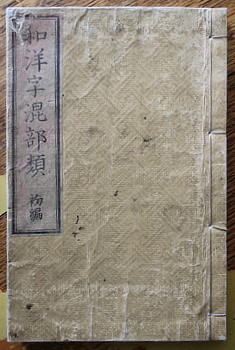
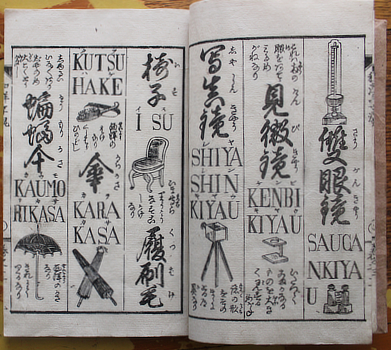
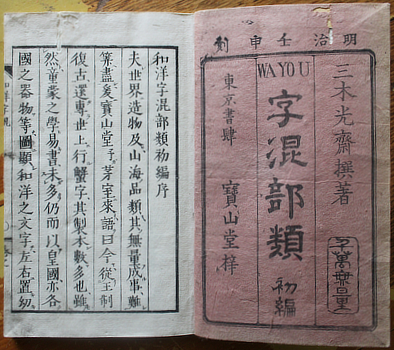
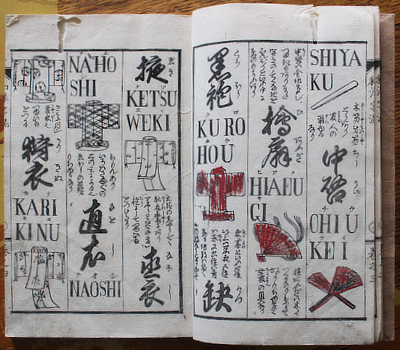
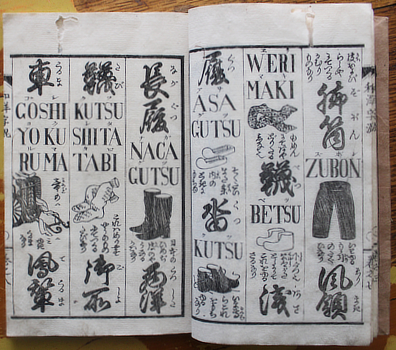

Miki Kosai (and/or Utagawa Yoshimori?) Wayou 字混部類 (和洋字混部類 on cover label). [Wayo Jikon Birui]. Tokyo, Hozando and others 1872 (Meiji 5). 18x12cm publisher's wrapper with title label (marked and a bit used); 30 leaves (60 pages) with small illustrations throughout. Inscription on the back cover; a voracious but neat bug has chewed a hole through the top margin of the first nine leaves and stayed outside the page borders; the first few illustrations with some neatish colouring. In all pretty good. Au$500
An endearing and uncommon little guide to placing stuff in the modern world: lots of common enough items and some that would soon become common, like clocks, binoculars, uncomfortable chairs, and cameras. Each is illustrated, named and described in Japanese and named in western capitals. But in phonetic Japanese, not English or any other European language, what would become romaji.
Miki Kosai signed the preface but Waseda attribute the book to Utagawa Yoshimori who presumably did the pictures. I'm inclined to believe Waseda. This is called part one but it seems no part two has ever been seen. Worldcat finds the NDL entry and a copy at the Huntington.
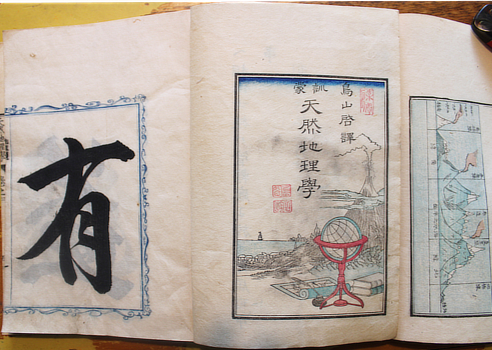
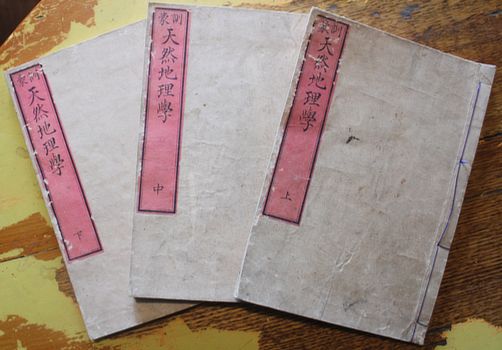
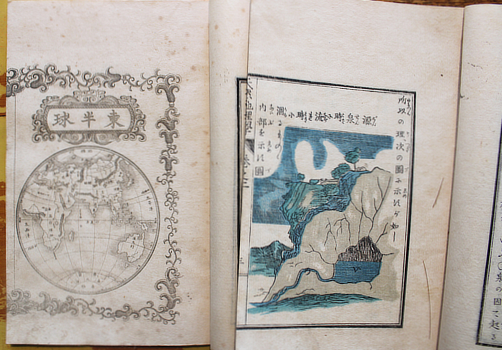

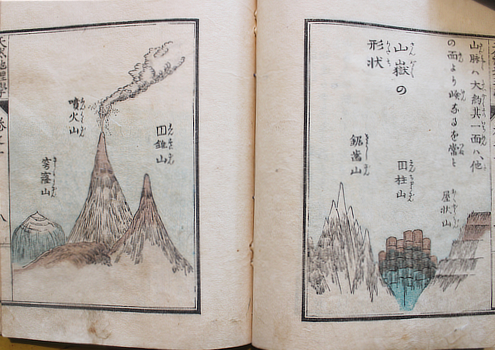

Sarah S. Cornell & Toriyama Hiraku. 天然地理学 [Tennen Chirigaku] Tokyo &c, Shoyusha 2533 (ie 1873 or Meiji 6). Three volumes, 22x15cm publisher' wrappers with title labels (marked). Coloured illustrations, maps and diagrams. Smudges and minor signs of use; rather good, specially for a school book. Au$500
Cornell's Primary Geography was printed in English for Japanese schools in 1866 - one of the first western school books in the country. I'm not sure which of her books has been translated here and I doubt it matters much. I guess they did their job: to mislead children, bore them, and induce a dislike of geography. The Japanese versions are nicer to look at than the blobby grey American originals.